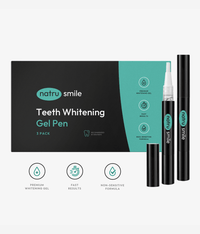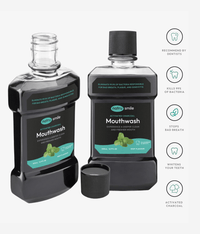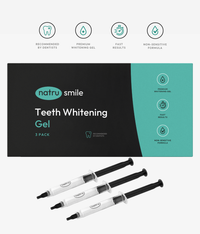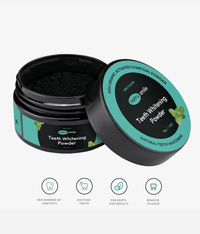
All products are certified by dental expert Dr. Greg Grillo
At home, your dental hygiene habits have major implications for your future oral health. Without daily effort, your teeth are left vulnerable to various dental issues.
The most obvious danger of not brushing twice daily is the buildup of plaque and bacteria, which leads to cavities, gum disease, tooth decay, and more significant problems like periodontal disease and tooth loss. Oral health can also impact your diabetes risk, as well as heart health and other medical conditions.
So how can you ensure that you're properly caring for your teeth? Here is a complete guide to at-home teeth cleaning.
Is It Possible To Clean Teeth Without Seeing A Dentist?
Seeing a dentist every six months is an important part of your overall oral care routine. But it won't do much to improve your smile if your daily routine doesn't include brushing and flossing.
That said, it is certainly possible to clean teeth without visiting a dentist. Brushing and flossing on a regular basis is an essential part of keeping the mouth healthy and free from cavities.
People can brush their teeth with a soft-bristled toothbrush, using fluoridated toothpaste at least twice a day to remove plaque. It is also important to floss your teeth regularly, as this will help to remove plaque buildup and food debris between the teeth.
Additionally, using an antibacterial mouthwash after brushing can help reduce bacteria in the mouth, preventing any oral health issues that may arise in the future.
By making these activities daily habits, your bi-annual dental visits will be much easier, more efficient, and completely devoid of surprises.
What Tools Do I Need To Properly Clean My Teeth At Home?
When it comes to adequately cleaning your teeth, there are a few things you'll need:
- A soft-bristled toothbrush: Soft bristles are less likely to irritate your gums, and will effectively remove plaque from the teeth.
- Fluoridated toothpaste: Fluoride toothpaste helps strengthen tooth enamel, making it more resistant to decay.
- Dental floss: Use dental tape or waxed floss for easier maneuverability between the teeth.
- An antibacterial mouthwash: Mouthwash is recommended for removing any additional bacteria and debris left behind after brushing and flossing.
- A tongue scraper (optional): This helps to remove bacteria from the tongue, which can contribute to bad breath.
- Baking soda or hydrogen peroxide (optional): Those who want a natural teeth whitening solution may opt to mix baking soda in their toothpaste or rinse with a hydrogen peroxide solution to whiten their teeth.
How Can I Clean My Teeth At Home?
You've heard it since you were a kid: Brush your teeth twice a day!
This is the single most important step you can take to maintain good dental health. It removes plaque and bacteria from your teeth, which reduces the risk of cavities, gum disease, and halitosis (bad breath).
But teeth cleaning is more than just that. To effectively clean your teeth, follow this step-by-step guide:
- Brush your teeth at least twice a day with a soft-bristled toothbrush and fluoridated toothpaste.
- Move the brush in small circular motions, covering all surfaces of each tooth as you go.
- Floss your teeth regularly to help remove plaque build-up and food debris from between the teeth.
- Use an antibacterial mouthwash after brushing to help reduce bacteria in the mouth.
- For occasional touchups or to brighten up your teeth at home, use over-the-counter whitening products such as strips or gels, baking soda, or hydrogen peroxide (though use sparingly as these have abrasive properties that can damage enamel over time).
- If you experience any persistent pain or sensitivity when cleaning your teeth, bad breath, or infection, visit a dentist for further examination and treatment as required.
Brushing your teeth twice daily is the key here. Any less than that, and you open yourself up to a host of health problems, including oral health issues, heart conditions, and even possible dementia.
Cleaning Teeth With Braces
Cleaning teeth with braces is similar to regular teeth cleaning, but involves a few extra steps:
- Brush your teeth at least twice a day with fluoride toothpaste and either a manual or electric toothbrush that has soft bristles.
- After brushing, flossing the teeth is essential to help remove any plaque build-up and food debris from between the teeth.
- If you have braces, use an interdental brush to clean around wires, brackets, and bands, as well as in between slots of pre-molar teeth where regular floss may be difficult to reach.
- Rinse your mouth with an antibacterial mouthwash following brushing and flossing for added protection against bad bacteria in the mouth.
- Use orthodontic wax as needed if your braces are causing any irritation or discomfort in the cheeks or gums when cleaning your teeth.
- Avoid using over-the-counter whitening products such as strips or gels, or natural products like baking soda, or hydrogen peroxide. These products won't reach underneath your braces and will cause uneven coloration on the surface of your teeth.
- If you experience any persistent pain or irritation when cleaning your teeth with braces, visit a dentist for further examination and treatment as required
If you have braces, food can get stuck in hard-to-reach places, making eating after brushing your teeth even worse. Be sure to use a toothpick or dental floss threader to clean these areas thoroughly, and rinse with water after each use.
Taking extra care of your teeth is important when wearing braces, and correctly brushing and flossing your teeth is essential for maintaining your teeth's appearance once you have them removed.
Are There Any Side Effects When Cleaning Teeth At Home?
There can be some side effects when cleaning teeth at home. The most common ones are related to the use of toothpaste and other products that contain abrasive materials.
When used over time, studies show that these materials can wear down tooth enamel, causing sensitivity and other dental issues.
The use of teeth whitening products can lead to irritation of gums or cheeks if used incorrectly or in excess. According to the ADA, this is the most common side effect of whitening, and it can be exacerbated by pre-existing sensitivity, product misuse, and using too many whitening products at once.
To relieve pain after teeth cleaning, you can rinse your mouth with warm salt water to reduce any discomfort. If the pain persists, ibuprofen or acetaminophen may also do the trick.
Will In-Chair Teeth Cleaning Have The Same Effect As At-Home Routines?
Dentists use high-quality tools and professional techniques to clean your teeth, guaranteeing a thorough job that can't be replicated at home.
In-chair cleaning is also used to look for cavities, detect oral health issues as soon as they occur, and provide advice on how to prevent further damage.
These treatments may be more expensive than DIY methods, but they offer a deeper clean and provide an early warning system for any oral health issues.
Since the dental cleaning duration is much longer in-office, it doesn't make sense to go through these procedures every day. And if you thoroughly brush and floss your teeth at home, your teeth will be as healthy as can be.
What Will It Cost To Clean Your Teeth At-Home?
Teeth cleaning costs can either be very low or very high, depending on what products and tools you use.
Brushing and flossing are both low-cost—most regular toothbrushes cost about $5, and dental floss is usually under $2.
If you choose to use an electric toothbrush, the price will be a bit higher but still relatively low—models with basic functions start around $20-20. Some models cost over $50 and replacement heads must be purchased separately.
If you have sensitive teeth after cleaning, you may opt for a specially-formulated toothpaste. These are usually a bit more expensive, typically ranging from $5-15. Teeth whitening options can range in price as well, depending on the type you choose and the brand.
Want to learn more? Here are a few questions our customers frequently ask us.
How Can I Remove Plaque From My Teeth At Home?
There are several at-home solutions to clean plaque from your teeth:
- Brush your teeth twice daily with a soft-bristled toothbrush and fluoridated toothpaste in small circular motions for at least two minutes to ensure all surfaces are properly covered.
- Floss at least once a day to help remove plaque build-up between the teeth, especially around braces or wires.
- Consider using interdental brushes or special flossers, especially with braces or other orthodontic appliances.
- Use an antibacterial mouthwash after brushing and flossing to reduce bad bacteria in the mouth.
- Eat crunchy fruits and vegetables such as apples, which can act as natural toothbrushes that scrape away plaque while you chew.
How Do You Clean Your Teeth Like A Dentist?
Regular brushing is enough for most people. But if you want to add an extra level of cleaning and protection, you can replicate the professional dental cleaning process in your own home. Here’s how:
- Use an electric toothbrush to get an extra-deep clean.
- Follow up with a fluoride rinse to help protect your teeth from decay and keep them strong.
- Floss in between the teeth and around braces, wires, and other appliances for a thorough cleaning.
- Consider using an oral irrigator to flush out food particles that can be missed with brushing and flossing.
- Use an antibacterial mouthwash for an extra layer of protection against decay and gum disease.
Are There Any Alternatives To Visiting The Dentist Twice Per Year?
Some find dental visits cost-prohibitive, uncomfortable, or inconvenient, but twice-yearly visits are important to ensure your mouth is in good health.
If you can’t visit a dentist in person, it's important to remember that there are no real substitutes for professional cleanings and assessments.
However, there are ways to supplement your at-home oral hygiene routine if you’re unable to visit the dentist:
- Schedule virtual appointments with a dentist, so they can assess your oral health remotely.
- Purchase an at-home teeth whitening kit if you’re looking for brighter teeth without professional help.
- Use over-the-counter oral care products to keep up with your routine and help prevent cavities and other dental issues.
Does Baking Soda Deep Clean Teeth?
Research proves that baking soda can be an effective way to deep clean teeth. Baking soda helps remove plaque and surface stains, making your teeth look brighter and whiter.
To use baking soda for whitening your teeth, simply dip a damp toothbrush in a small amount of baking soda and brush for two minutes. Rinse with water afterward. You can also mix 1 teaspoon of baking soda with 2 teaspoons of hydrogen peroxide to make a paste. Apply the paste on your teeth and leave it for one minute before rinsing with water.
How Do You Clean Yellow Teeth?
Regular teeth cleaning can whiten your teeth, but cleaning yellow teeth might require whitening products in conjunction with regular brushing and flossing.
Whitening toothpaste, mouthwashes, strips, and gels are all designed to help remove surface stains. If over-the-counter products don’t work, you can consider professional teeth whitening treatments like in-office bleaching or at-home kits with custom trays.
Final Thoughts
At-home teeth cleaning is a critical element of oral hygiene and overall health. And with the right knowledge and supplies, you can easily do it yourself.
Make sure to brush your teeth at least twice a day with fluoridated toothpaste, floss daily, use an antibacterial mouthwash, rinse with fluoride, and consider using whitening products or professional treatments if necessary.
And remember: Consistency is the most important part—brushing and flossing regularly is the key to a brighter, cleaner smile.










